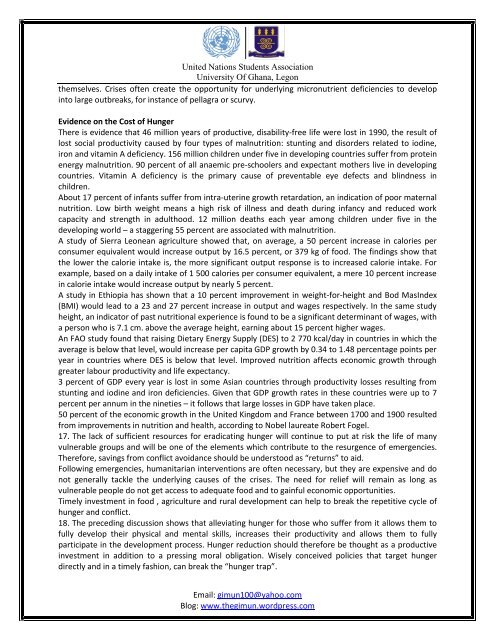United Nations Students Association University Of Ghana, Legon ...
United Nations Students Association University Of Ghana, Legon ...
United Nations Students Association University Of Ghana, Legon ...
Create successful ePaper yourself
Turn your PDF publications into a flip-book with our unique Google optimized e-Paper software.
<strong>United</strong> <strong>Nations</strong> <strong>Students</strong> <strong>Association</strong><br />
<strong>University</strong> <strong>Of</strong> <strong>Ghana</strong>, <strong>Legon</strong><br />
themselves. Crises often create the opportunity for underlying micronutrient deficiencies to develop<br />
into large outbreaks, for instance of pellagra or scurvy.<br />
Evidence on the Cost of Hunger<br />
There is evidence that 46 million years of productive, disability-free life were lost in 1990, the result of<br />
lost social productivity caused by four types of malnutrition: stunting and disorders related to iodine,<br />
iron and vitamin A deficiency. 156 million children under five in developing countries suffer from protein<br />
energy malnutrition. 90 percent of all anaemic pre-schoolers and expectant mothers live in developing<br />
countries. Vitamin A deficiency is the primary cause of preventable eye defects and blindness in<br />
children.<br />
About 17 percent of infants suffer from intra-uterine growth retardation, an indication of poor maternal<br />
nutrition. Low birth weight means a high risk of illness and death during infancy and reduced work<br />
capacity and strength in adulthood. 12 million deaths each year among children under five in the<br />
developing world – a staggering 55 percent are associated with malnutrition.<br />
A study of Sierra Leonean agriculture showed that, on average, a 50 percent increase in calories per<br />
consumer equivalent would increase output by 16.5 percent, or 379 kg of food. The findings show that<br />
the lower the calorie intake is, the more significant output response is to increased calorie intake. For<br />
example, based on a daily intake of 1 500 calories per consumer equivalent, a mere 10 percent increase<br />
in calorie intake would increase output by nearly 5 percent.<br />
A study in Ethiopia has shown that a 10 percent improvement in weight-for-height and Bod MasIndex<br />
(BMI) would lead to a 23 and 27 percent increase in output and wages respectively. In the same study<br />
height, an indicator of past nutritional experience is found to be a significant determinant of wages, with<br />
a person who is 7.1 cm. above the average height, earning about 15 percent higher wages.<br />
An FAO study found that raising Dietary Energy Supply (DES) to 2 770 kcal/day in countries in which the<br />
average is below that level, would increase per capita GDP growth by 0.34 to 1.48 percentage points per<br />
year in countries where DES is below that level. Improved nutrition affects economic growth through<br />
greater labour productivity and life expectancy.<br />
3 percent of GDP every year is lost in some Asian countries through productivity losses resulting from<br />
stunting and iodine and iron deficiencies. Given that GDP growth rates in these countries were up to 7<br />
percent per annum in the nineties – it follows that large losses in GDP have taken place.<br />
50 percent of the economic growth in the <strong>United</strong> Kingdom and France between 1700 and 1900 resulted<br />
from improvements in nutrition and health, according to Nobel laureate Robert Fogel.<br />
17. The lack of sufficient resources for eradicating hunger will continue to put at risk the life of many<br />
vulnerable groups and will be one of the elements which contribute to the resurgence of emergencies.<br />
Therefore, savings from conflict avoidance should be understood as “returns” to aid.<br />
Following emergencies, humanitarian interventions are often necessary, but they are expensive and do<br />
not generally tackle the underlying causes of the crises. The need for relief will remain as long as<br />
vulnerable people do not get access to adequate food and to gainful economic opportunities.<br />
Timely investment in food , agriculture and rural development can help to break the repetitive cycle of<br />
hunger and conflict.<br />
18. The preceding discussion shows that alleviating hunger for those who suffer from it allows them to<br />
fully develop their physical and mental skills, increases their productivity and allows them to fully<br />
participate in the development process. Hunger reduction should therefore be thought as a productive<br />
investment in addition to a pressing moral obligation. Wisely conceived policies that target hunger<br />
directly and in a timely fashion, can break the “hunger trap”.<br />
Email: gimun100@yahoo.com<br />
Blog: www.thegimun.wordpress.com


